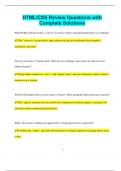Exam (elaborations)
Test Bank For Organizational Behaviour Understanding and Managing Life at Work, 12th Edition by Gary Johns, Alan M. Saks Chapter 1-15
- Course
- Institution
Test Bank For Organizational Behaviour Understanding and Managing Life at Work, 12th Edition by Gary Johns, Alan M. Saks Chapter 1-15
[Show more]




